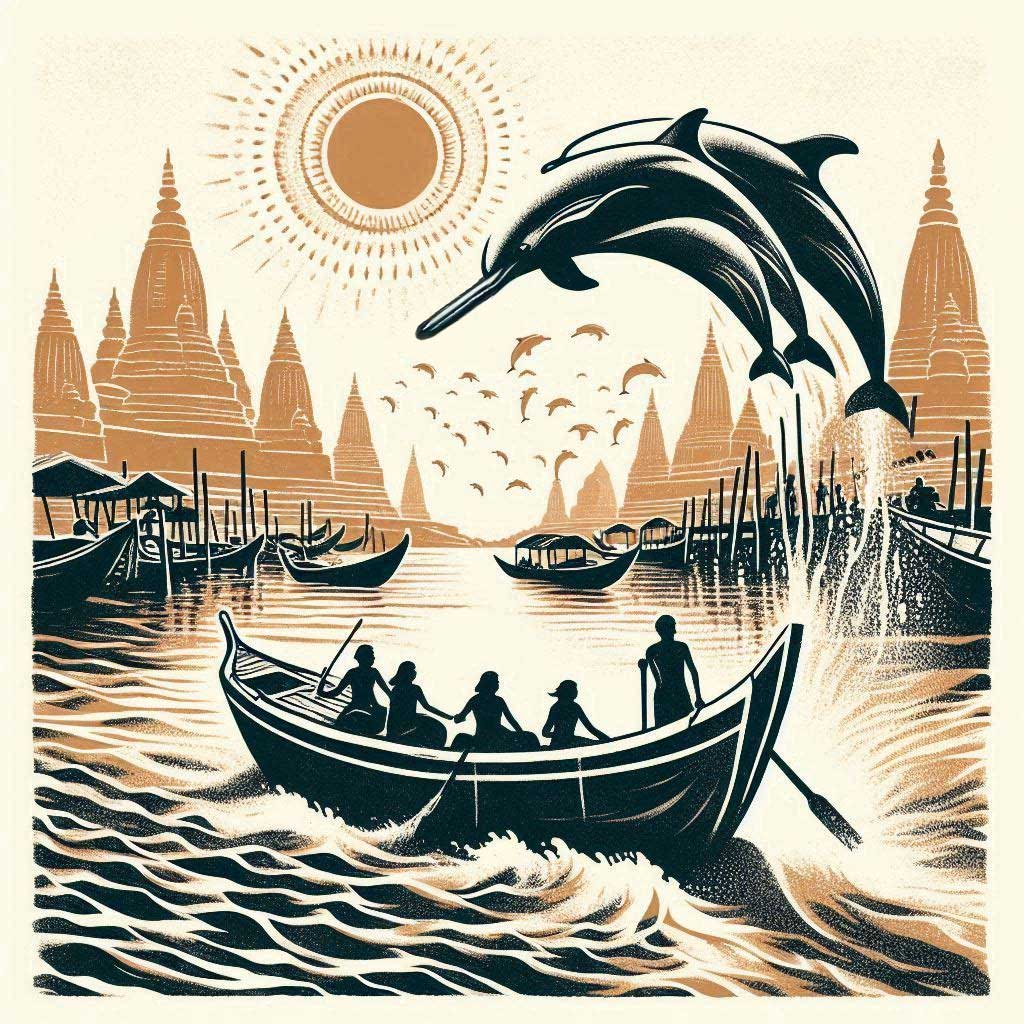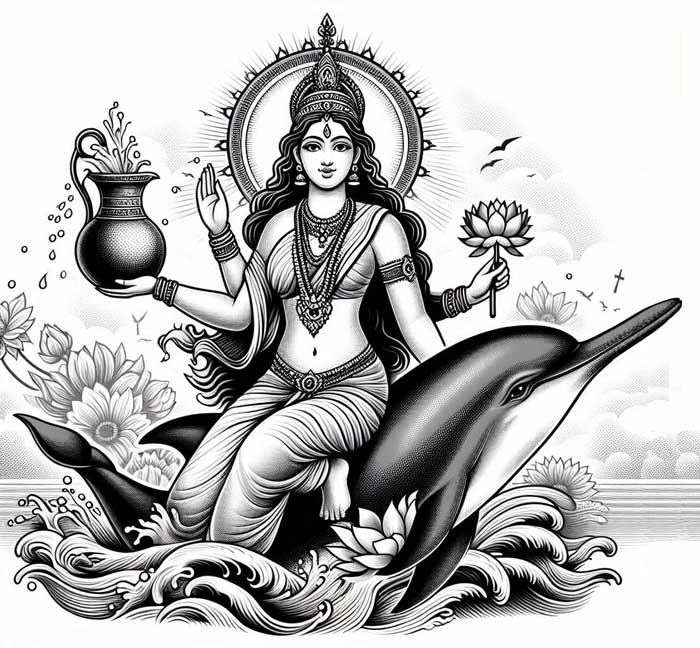
I was in Varanasi, India, with my girlfriend, and we had decided to take a boat ride along the sacred Ganges River. The Ganges is more than just a river here; it’s the spiritual heartbeat of Varanasi, a place where life, death, and rebirth meet in a constant cycle. The river is seen as a goddess, Ganga, who offers purification and a path to salvation. People come from all over India to bathe in its waters, perform rituals, and seek spiritual solace. It’s a place where time seems to stand still, and the air is thick with devotion and centuries-old traditions.
We shared the boat with two well-dressed Indian businessmen, and it was refreshing to hear their perspectives as we cruised along the river. They spoke of life, business, and the importance of tradition. We were all enjoying the tranquil flow of the Ganges when suddenly, out of nowhere, two dolphins leapt from the water near our boat. Their sleek bodies arced gracefully in the air before disappearing back into the river. I was in awe, completely taken aback by their beauty. It was one of those moments where nature gives you a gift so unexpected that you can’t help but feel a deep sense of wonder.

Excited, I turned to the businessmen to share what I’d seen. But to my surprise, they burst into laughter. They insisted there were no dolphins in the Ganges, finding the very idea utterly absurd. Their laughter echoed across the river, but I was absolutely certain of what I had just witnessed. I had seen the dolphins with my own eyes—their distinct long snouts cutting through the water. Later, I decided to do some research, and as it turned out, I was right! Ganges river dolphins do exist. These creatures are a rare species, known for their unique snouts and their ability to thrive in the murky waters of the river. They’re often elusive, and many locals are unaware of their presence. This made my encounter all the more special, as if the river had shared one of its hidden secrets with me that day.
In Hindu culture, seeing a Ganges River Dolphin is considered to be auspicious and is believed to bring good fortune. This is because the dolphin is associated with the goddess Ganga, who is revered for her purifying and cleansing powers. According to Hindu belief, bathing in the waters of the Ganges river and receiving the blessings of Ganga can wash away sins and bring spiritual purification.
In Hindu mythology, Ganga is often depicted as a beautiful woman with a water pot in her hand and a lotus flower in her other hand. She is sometimes shown riding on a dolphin, which is considered to be her vehicle. Ganga is also associated with purity, forgiveness, and salvation, and is believed to have the power to wash away sins and grant spiritual liberation.

The Dolphin Pose, while it may feel like hard work at first, plays a vital role in preparing us for postures that symbolize freedom, exploration, and inversion—namely the headstand and forearm stand (and eventually handstand). It’s almost like a bridge between the groundedness of foundational poses and the exhilarating freedom of inversions. Dolphins themselves, as mythological symbols, represent agility, grace, and the ability to move seamlessly between realms—the land of air (breath) and water (the emotional and subconscious world). Similarly, in yoga, Dolphin Pose acts as this pivotal point of transition.
Hard Work for the Reward of Freedom
Now, let’s acknowledge this: Dolphin Pose is hard work! There’s no question about it. The shoulders burn, the core engages, and the hamstrings stretch in ways that challenge us from the start. But it’s through this challenge that we start to earn the freedom and ease that come later in postures like headstand or handstand. The work we do in Dolphin builds the foundation for these advanced postures by strengthening our arms, shoulders, and core, but more importantly, it helps us cultivate the balance and grounding necessary to invert our bodies confidently.
Much like the dolphin itself, which moves with fluidity and playfulness through water, we too must learn to embrace the hard work with a similar mindset. Dolphins don’t fight the currents—they move with them. In Dolphin Pose, we learn to find the same flow, adapting to the demands of the posture with grace and persistence. Initially, it may feel like you’re battling the waves, but with time, it becomes less about effort and more about finding rhythm—a beautiful balance between strength and surrender.
Mythological Connection: Dolphins as Navigators
In many mythological stories, dolphins are depicted as navigators—guiding ships, saving sailors, and even serving as messengers between the gods and humanity. In the same way, Dolphin Pose guides us through the mental and physical challenges of preparation, helping us navigate toward the inversions where we literally turn our perspective upside down.
When we finally progress from Dolphin Pose to headstand or forearm stand, the sense of freedom we experience is remarkable. There’s a release that comes when the body is inverted, a weightlessness that can only be achieved by mastering that initial foundation. It’s like the dolphin that leaps joyfully from the ocean into the air—effortlessly and with grace—because it has learned to navigate both the water and the air with skill. In the same way, we prepare through Dolphin Pose to “leap” into inversions, where we experience the beauty of flight.
Grounding Before Flight
Before we take flight into an inversion, however, grounding is key. This is where Dolphin Pose plays an even deeper role. As much as inversions are about freedom, they also require us to be anchored—firmly rooted in our foundation, especially through the arms and core. Dolphin Pose teaches us to press into the ground with intention, to find stability through the forearms, and to engage the core muscles that provide the stability necessary for flight.
It’s not just about physical preparation either—there’s a mental component to this practice. Dolphin Pose, with its intensity, requires focus and discipline. It asks us to stay present, to breathe through discomfort, and to trust that the hard work will pay off. This mental fortitude is just as important when we attempt inversions because there’s a moment of vulnerability when we lift our feet off the ground. It’s the trust that we’ve done the work in Dolphin Pose that allows us to let go and explore the freedom of an inversion.
Earning Freedom through Hard Work
The exploration and freedom that come with headstands, handstands, and forearm stands aren’t just gifts that come without effort. They’re earned through the dedication and groundwork we lay in poses like Dolphin. It’s as if Dolphin Pose is the “workshop” where we practice all the fundamental skills—strength, balance, grounding, and breath control. Once we’ve integrated those into our practice, inversions become expressions of that freedom.
This reminds me of how dolphins, in mythology and nature, are constantly exploring their environments with both power and playfulness. They’re not confined to the surface of the water—they explore the depths and leap into the air with the same confidence. Our practice mirrors this, and Dolphin Pose is the gateway that allows us to move beyond the surface and explore the more liberating aspects of yoga postures.

Playful Strength, Earned Freedom
So, while Dolphin Pose may feel intense, it’s really about teaching us playful strength—the kind that’s grounded in effort but results in ease. It’s about earning our freedom through disciplined practice and eventually soaring into the inversions that allow us to explore the world from a new perspective.
Much like dolphins are known for their intelligence and joyful approach to life, we can embrace Dolphin Pose with that same mindset. The pose may challenge us at first, but through that challenge, we unlock the freedom to explore headstands, handstands, and beyond—just as the dolphin navigates the depths of the ocean and the heights of the air with grace and ease.
The effort we invest in detoxifying and strengthening our bodies in Dolphin Pose mirrors the commitment needed to cleanse the polluted Ganges River and save the endangered Ganges dolphin. Just as our bodies require dedication to release toxins and explore their full potential, the river demands our collective effort to restore its purity and protect the life it sustains. By healing ourselves, we tap into freedom and possibility; by healing the Ganges, we preserve the delicate balance of nature. As we cleanse our bodies, we must also cleanse the world around us, for both are sacred.
